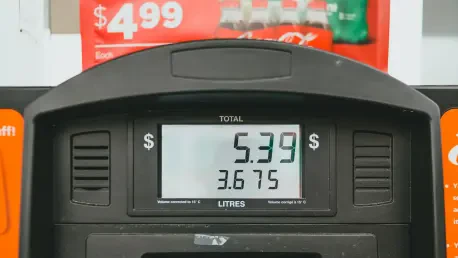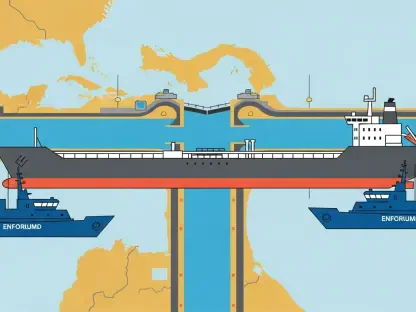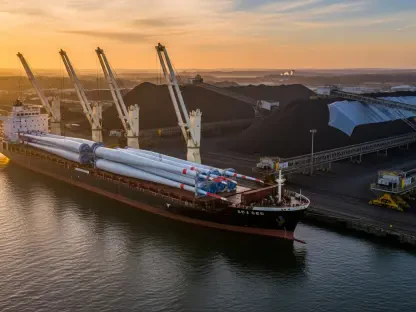The global oil market stands at a critical juncture, wrestling with the looming threat of oversupply while being entangled in a web of uncertainties that could paradoxically prevent a price collapse. Brent crude oil prices have recently slumped to around $61 per barrel, marking the lowest level since May, as forecasts point to substantial surpluses in the coming years. The International Energy Agency (IEA) has sounded alarms over potential gluts, projecting excesses that could reshape market dynamics. Yet, amidst these bearish indicators, a surprising stabilizing force emerges from the opacity surrounding the production levels of the Organization of the Petroleum Exporting Countries (OPEC). This intricate balance between oversupply fears and data ambiguities creates a complex landscape where prices may find an unexpected floor. This article delves into the key factors driving current market trends, examining how conflicting forces are influencing oil price trajectories and what this means for stakeholders across the industry.
Oversupply Projections Cast a Long Shadow
The oil market is increasingly overshadowed by predictions of a significant glut, with the IEA estimating a surplus of 2.35 million barrels per day (bpd) in the near term, escalating to a staggering 4 million bpd by 2026, which equates to nearly 4% of global demand. This anticipated oversupply stems from robust production increases by OPEC+ members alongside other major producers, even as global demand holds steady despite geopolitical tensions and trade policy uncertainties. Such projections paint a daunting picture for oil prices, suggesting a market teetering on the edge of saturation. The implications of this surplus are profound, as they could exert sustained downward pressure on prices, affecting not only producers but also economies reliant on oil revenues. The scale of the forecasted excess raises questions about how the industry will adapt to a landscape where supply consistently outstrips consumption, potentially forcing strategic shifts among key players to mitigate financial impacts.
Compounding the concern over oversupply is the market’s structural response, which signals deepening pessimism among traders and analysts alike. A shift to a contango structure, where futures contracts for later delivery are priced at a discount to future expectations, reflects a growing belief in an impending surplus. This pattern stands in stark contrast to earlier periods of optimism when tight inventories and resilient demand propped up price expectations. Now, contango indicates that traders anticipate rising storage costs and oversupply pressures, further eroding confidence in near-term price recovery. This market configuration not only underscores the bearish sentiment but also highlights how quickly perceptions can shift in response to evolving supply-demand dynamics. As a result, investors are recalibrating their strategies, bracing for a period of potential price weakness that could challenge the profitability of production activities across the sector.
Uncertainties Around OPEC Output Create a Buffer
Amid the bearish outlook driven by oversupply fears, a critical counterforce emerges in the form of uncertainty surrounding OPEC’s production levels, which account for nearly 30% of global oil supply. Recent analyses, such as those from Morgan Stanley, reveal a striking divergence in output estimates, with variations reaching as high as 2.5 million bpd in September alone, representing about 9% of the group’s total production. This wide range of assessments creates a significant blind spot for market participants, who find it challenging to make informed decisions without reliable data. Such ambiguity acts as a restraint on aggressive bearish positioning, as traders hesitate to fully commit to price declines without clearer insights into OPEC’s actual contributions. The lack of transparency within this influential bloc introduces a layer of caution that could prevent oil prices from spiraling downward, even as surplus forecasts dominate headlines.
Further complicating the situation is the internal ambiguity within OPEC itself, as member states grapple with discrepancies in reported production capacities and actual output. Recent moves, such as Kuwait’s initiative to engage top consultants to evaluate member production levels, underscore the depth of uncertainty even among insiders. This opacity not only affects market perceptions but also hinders coordinated policy responses that could address oversupply risks. For investors, the absence of consistent data from a group as pivotal as OPEC fosters a wait-and-see approach, tempering the momentum of bearish bets. As a result, while the fundamentals of oversupply suggest a downward trajectory for prices, the unresolved questions surrounding OPEC’s true production capabilities provide a potential stabilizing effect, keeping the market from fully embracing a collapse in valuations. This dynamic illustrates the intricate interplay between data reliability and market sentiment in shaping oil price trends.
Global Data Gaps Amplify Market Confusion
Beyond the specific uncertainties tied to OPEC, broader challenges in tracking global oil flows contribute to a pervasive sense of confusion in the market. Western sanctions on Russia have given rise to a shadowy parallel market that defies accurate monitoring, obscuring the true volume of oil in circulation. Simultaneously, China’s aggressive stockpiling efforts, which have added an estimated 225 million barrels to global inventories this year, lack the transparency needed for precise assessments. These gaps in data create a fragmented picture of supply and inventory levels, leaving analysts and traders without the clarity required to predict market movements with confidence. The IEA’s recent report, which failed to account for 1.47 million bpd of crude, exemplifies the scale of these challenges, highlighting how incomplete information can distort perceptions of balance in the oil market and influence pricing strategies.
Adding to the complexity are the divergent forecasts from major institutions, which further muddy the waters for market participants. While the IEA warns of an impending glut reminiscent of the demand collapse seen in 2020, OPEC presents a more balanced view of supply and demand dynamics over the near term. This lack of consensus, coupled with reports of global oil stocks reaching a four-year high as of August, fosters hesitation among traders who are reluctant to fully price in the anticipated oversupply. The conflicting signals from authoritative bodies create an environment where caution prevails over decisive action, as stakeholders grapple with the implications of competing narratives. Consequently, the market remains in a state of flux, caught between the tangible risks of excess supply and the intangible uncertainties that prevent a unified response, shaping a landscape where price stability may inadvertently emerge from indecision.
Historical Responses and Future Price Floors
Looking to historical patterns offers a potential silver lining amid the current bearish sentiment, as past market behaviors suggest a natural corrective mechanism to low prices and oversupply signals. In previous cycles, contango structures and depressed price levels have often prompted producers, particularly U.S. shale operators, to curtail drilling and investment activities. Although recent data indicates only a modest 13% reduction in U.S. oil rig counts this year, the precedent of scaling back in response to unprofitable conditions—especially with prices hovering near $57 per barrel for many operators—remains relevant. Such historical tendencies hint at the possibility that sustained low prices could eventually temper production growth, creating a de facto floor under oil prices even as surplus projections dominate the discourse. This adaptive response from producers could serve as a critical buffer against further declines.
Moreover, the resilience of major oil companies in maintaining spending levels, despite current price challenges, suggests that the industry may not be anticipating a prolonged downturn. While smaller operators face profitability concerns, larger players appear to be adopting a longer-term view, potentially buoyed by expectations of market stabilization driven by production adjustments over time. This divergence in strategy between different segments of the industry underscores the nuanced impact of historical lessons on current decision-making. As the market navigates the dual pressures of oversupply and uncertainty, these past patterns provide a framework for understanding how price floors might emerge organically. The interplay between producer behavior and market conditions will likely play a pivotal role in determining whether oil prices can find a sustainable level, offering a counterbalance to the prevailing narrative of inevitable decline in the face of excess supply.
Navigating a Complex Market Landscape
Reflecting on the intricate dynamics that have defined the oil market in recent times, it becomes evident that the interplay between oversupply risks and data uncertainties creates a uniquely challenging environment. The stark warnings of surpluses from authoritative bodies like the IEA are met with equally significant ambiguities around OPEC production levels and global inventory assessments, crafting a scenario where caution often trumps decisive action. Brent crude prices, lingering near historic lows, bear the weight of bearish fundamentals, yet the persistent lack of clarity acts as a subtle shield against a steeper fall. This delicate balance underscores how opacity in critical market data can, ironically, serve as a stabilizing factor in times of potential crisis.
Moving forward, stakeholders are encouraged to prioritize enhanced transparency and data reliability as essential steps to mitigate the risks posed by oversupply. Collaborative efforts to refine production estimates and track global flows more accurately could help bridge the gap between conflicting forecasts, enabling more informed decision-making. Additionally, monitoring producer responses, particularly in the U.S. shale sector, offers a vital indicator of potential price floors. As the industry adapts to these evolving challenges, a focus on strategic adjustments and improved market visibility emerges as key considerations for navigating the uncertain road ahead, ensuring that stability can be achieved even amidst persistent volatility.









